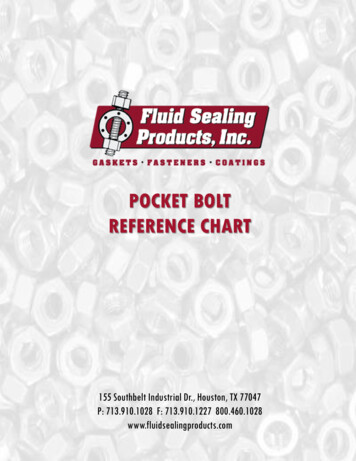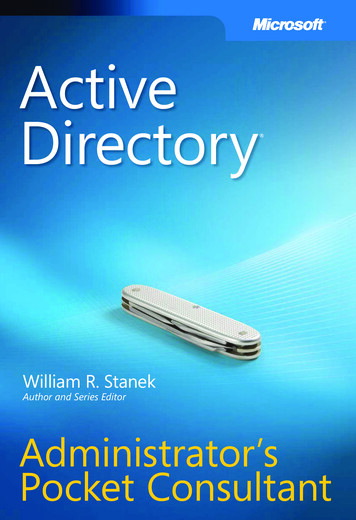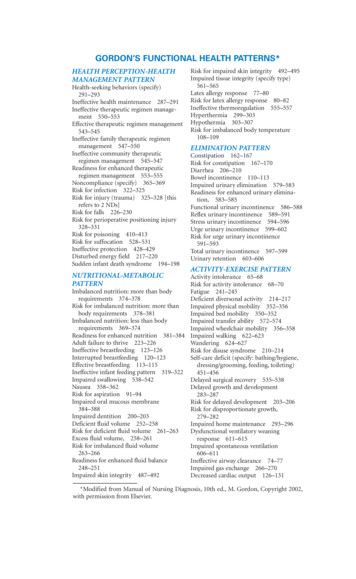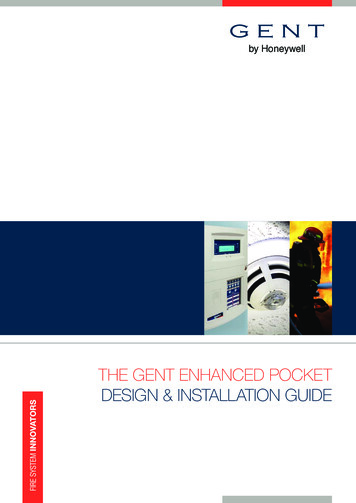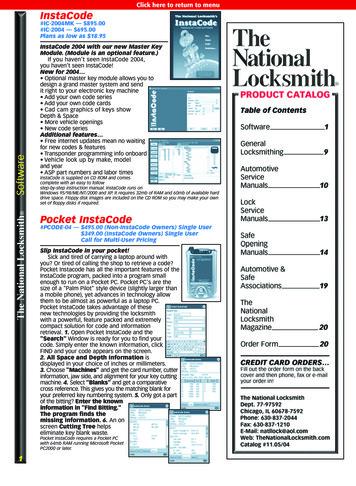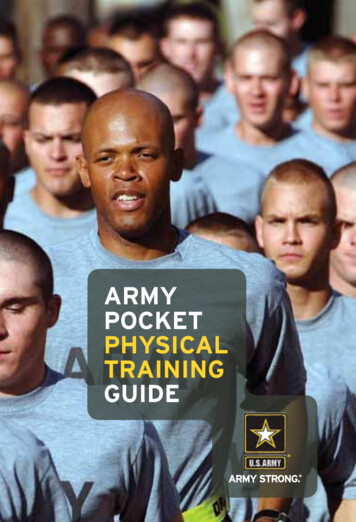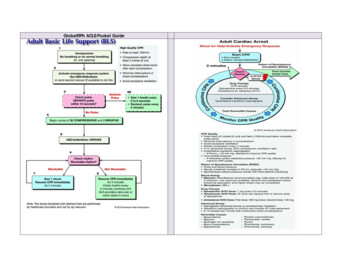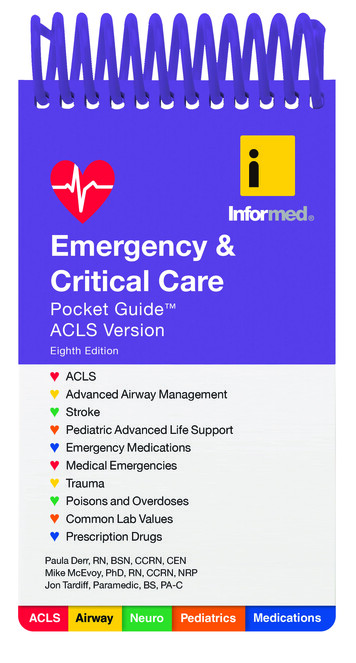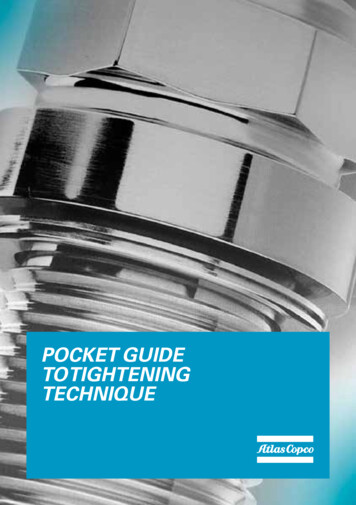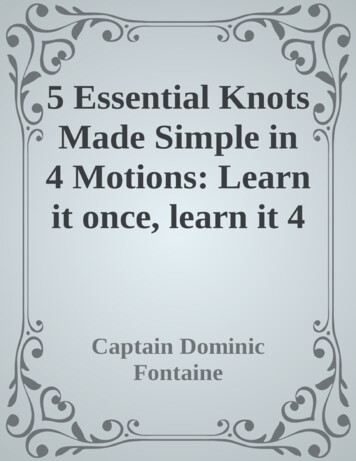
Transcription
The Ultimate Pocket Reference5 BONUS:
Cleat Tying &Line CareEssEnTialKnotsmadE simPlE4inmotionslEaRn iT onCElEaRn iT 4 liFEby Captain dominic FontaineThe Ultimate Pocket Reference 5 BONUS:Cleat TyingLine Care &EssEnTialKnotsmadE simPlE4inmotions
lEaRn iT onCElEaRn iT 4 liFEby Captain dominic FontaineacknowledgementsTo my friends who assisted me in the production of this book Capt. Ken &Elaine BarnesVincent R. JonesJohn BerhardJanalle Lavoychemical engineerKevin BurkephotographerJohn ManasMarci CasasTom Masseyowner of the Study Hal .comMaine Vineyard Management.com(Rockport, ME)Bob MatoonOwen CasasAlison & Kristen McKeller
independent candidateKar Creativefor representative ofMaine House District 94Jim & Cyndi Ostrowski(Camden/Rockport)Inns at Blackberry CommonMike ColeSteve Ozerfireman/instructorKim & Peter Palermo(Thomaston, ME)owners of Elm Street MarketingSteve CorsonEssentialsCorson's Auto SupplyLora PellegriniPaul DooreAlfred Sandy Reynoldschief flight instructor
Ben DushkuFAA examinerGreen Star TreeJoe ShamonElizabeth Fontainemy motherJonathan SperaAna K. ForgitMr. & Mrs. SperaRusselsofCamden.comKristine D. ForgitElizabeth ThurberShane & Liz HendrickEnaturedesignstudios.comTreeworksEmily ThurberKaren HolmesToby Winklhophereditorcommercial diver / lobsterman
There are many more people that I admire and appreciate, who havecontributed to the end product of this book.ContentsIntroductionHow to Use This BookKnot 1: Standard Bowline—a fixed loopStandard Bowline - Beginners Technique Standard Bowline - AdvancedTechniqueRunning BowlineRunning Bowline Over an Open-ended Object Knot 2: Sheet Bend—connectstwo line ends Double Sheet BendKnot 3: Clove Hitch & Double Clove Hitch—connects a line to a post or railDouble Clove HitchClove Hitch With Two Half HitchesClove Hitch Over an Open-ended ObjectKnot 4: Prusik—connects a line to any part of a line Knot 5: Figure Eight—safety stopper at a line’s end Tying to a Cleat—directed to marinersLine Care and StorageTimelineGlossary
5 Essential Knots Made Simple in 4 Motions introductionOf the many books on knot tying, none illustrate as well as the few simplehand motions needed to quickly master the most basic knots as 5 EssentialKnots Made Simple in 4 Motions.Author Dominic Fontaine, sea captain, licensed arborist, aviator and trucker,details the 5 essential knots he uses continuously in his work, demonstratingstep by step the easy hand maneuvers he teaches to coworkers of variousprofessions.Parts of the line/Ropein Knot FormationStanding end:working portion, notused in completionof knot
bight:loop or turnin the linebitter end:terminal endloop:fundamentalstructure intying manyknots5 Essential Knots Made Simple in 4 Motions How to Use This BookSuccess in learning these knot-tying skills depends on dili-gently followingthe instructions in the pages to follow, with total abandonment of one’screativity. Each knot and its accom-panying motions are depicted overmultiple photos for ease of understanding. For this reason, you may be led toperceive that there are more than the four motions as implied by the book’stitle. However, it is important to remember that a motion is a fluid sequenceof actions, and those actions tend to overlap. As you develop these skills, thetying process will become more seamless and less staggered, resembling thefluidity of a ballet dancer or martial artist.Also keep in mind that the four motions pertain to the five CORE knots—bowline, sheet bend, clove hitch, prusik, and figure eight—and notnecessarily their variations.It’s important to begin with a firm understanding of the three knot-tying
steps:1. Tie—formation of knot2. Organize/dress—arrangement and shaping of its parts 3. Set—loading toensure securityFor best results, practice daily for short periods of time. Once you think youhave mastered a given knot, attempt to tie the knot after a week withoutpractice to confirm that you have retained the skill. The learning curve willvary from person to person.5 Essential Knots made simple in 4 motions a Simple Knot to the rescuetwo hours has turned into 24 on an exploration hike gone wrong. You’restranded on the rocky ledges of a mountain in a foreign country andthere are no organized rescue operations nearby. You’re weak, tired andyour morale is setting with the sun. the silence is abruptly broken withthe sound of whirring rotors and the surge of a turbine as a helicopteremerges from behind the ridge.Words can’t explain your excitement, but you’re not off the ledge yet.above you hovers a privately owned chopper from which a naked line issuspended. Can you tie a simple knot to save your life?
5 Essential Knots Made Simple in 4 Motions Possible Applications ofStandard BowlinesStandard bowlinesin terminal ends ofhardware, loweringline and tag line,both girth hitched to
control timber.Bowlines at anchor points for tie down of aircraft.
Beginners TechniqueStandardBowlinestandard BowlineBeginners Techniquearea not visible when standing
12standard BowlineBeginners Technique34
standard BowlineBeginners Technique56
standard BowlineBeginners Techniqueleft hand7pinches bightto secure
structureof the knotbeingformed.rotate line end#28to the leftrabbit goes aroundthe back of the treebehind thestanding end.#3rabbit goesback downthrough thehole#1rabbit goesup through
the holestandard BowlineBeginners Technique9
Advanced TechniqueStandard
Bowlinestandard Bowlineadvanced Technique with Hand motions area not visible when standingbeginning grasp1Motion 1
2left handmakes a looparound thebitter end.standard Bowline advanced Technique with Hand motions Motion 1(cont.)
3Motion 1 (cont.)Slide standing4end of line fromin front of theleft handback toyour lefthand.
standard Bowlineadvanced Technique with Hand motions Motion 25line endexits loop.Motion 2rotate line end#26to the leftrabbit goes aroundthe back of the treebehind the
standing end.#3rabbit goesback downthrough thehole#1rabbit goesup throughthe hole
standard Bowline advanced Technique with Hand motions Motion 3pass line end from7the right hand downthrough the hole.Motion 4pull the three8parts of theline—thestanding end,loop, and bitterend—to set
the knot.5 Essential Knots made simple in 4 motions Possible Applications ofRunning Bowlinestie a running bowline to set the tension with your body weight.Secure with a double clove hitch and two half hitches (pgs 39 & 43) on aninterior handle, or secure with 5 long rolling tucks across the top of themattress width.** Check with state and federal regulations before attempting this task.Each situation must be evaluated for safety purposes. Care shouldbe taken to avoid personal or property damage.
RunningBowline
Running BowlineStep 1pass line around object about to be choked.1Step 2pass line end around standing end of line.
2Running Bowline Motion 1tie bowline to completed knot. refer to page 7.3Motion 24
Running BowlineMotion 2 (cont.)1Motion 3pull the three parts of line—the standing part, the fixed loop, and the lineend—to set the knot.6
Running Bowline Motion 4apply tension to the standing end to lock onto the fixed object.7
5 Essential Knots Made Simple in 4 Motions Possible Applications ofRunning Bowline Over anOpen-ended Object
RunningBowline
Over an Open-endedObjectRunning Bow line over an open-Ended object Create a standard bowline.1Motion 1reach up through the bowline to receive the standing end of the line fromyour right hand.
2Running Bow line over an open-Ended object Motion 2pull enough of thethe bowline tostanding end of
choke the desiredthe line throughobject.3Motion 3drape the adjustable loop over the object.4Motion 4pull standingend to set andsecure.5
5 Essential Knots made simple in 4 motions Possible Applications ofSheet Bend KnotRecovery from ditch.Note: Use at least 1:5 ratio of tensile strength of lineappropriate for the weight of the vehicle. Undersized linescan cause injury or death.
Sheet BendConnects Two
Line Endssheet Bend; Connects Two linesbeginning grasp: blue line crosses in front of With your left hand, pinchblue line over red line.red line.Do not changeyour left hand
grasp untilthe knot iscompleted.1Motion 1With your right hand, follow the arrow here, wrapping the standing endof the red line around the back of the bitter end of the red line, Motion 1in a clockwise rotation.2
sheet Bend; Connects Two linesMotion 2Motion 2:With your rightMotion 2hand, bend blueline end throughred line bight,following yourleft thumb tip tothumb base.3
Motion 3pull both parts of the blue line and the red line simultaneously.4sheet Bend; Connects Two linesMotion 4pull the blue line end, the bluestanding end, and the redstanding end to set.5
5 Essential Knots made simple in 4 motions Possible Applications ofDouble Sheet Bend KnotDouble Sheet Bend —recommended for marryingtwo lines of different sizes.Note: Use at least 1:5 ratio of tensile strength of lineappropriate for the weight of the vehicle. Undersized linescan cause injury or death.
DOuBLEShEET BEnD
double sheet BendMotion 1bring red bitter1end up throughblue loop awayand to the left,over left indexfinger.Motion 2rotate red bitter2end underneath
blue loop towardyourself.double sheet BendMotion 3Follow your index3
finger with red bitterend underneath thered bight.repeat motions 2 and 3.4double sheet BendMotion 4after organizing knot shape, pull the three line parts—blue bitter end,blue standing end, and red bight—to set.
5 Essential Knots Made Simple in 4 Motions Possible Applications of
Clove hitchUse of Clove Hitch as a visual and physical barrier,in a decorative way.
Clove hitch& Double Clove hitch
Clove HitchMotion 1Cross object with line from1left to right.Motion 2
rotate bitter end around object. Cross the 2standing end making an “X” with the bitter end to the left.Clove HitchMotion 3return the bitter end to the front3
and tuck beneath previous turn,parallel, chasing the previous turn in the opposing direction.Motion 4pull both the standing and bitter end 4to set.NOTE: holding power is weak on slick objects.double Clove HitchDouble Clove hitchtie a single clove hitch. rotate bitter end around object and underneathitself and set.repeat process for addedsecurity or to cover a railin a decorative finishwith “small stuff”*.
* small stuff—small diameterline such astwine, waxedthread, etc.5 Essential Knots Made Simple in 4 Motions explore camden harborFisherman’s ClassicPeapod Row BoatExplore the Harbor on your own.Contact: Captain Dominic Fontaine
for rental .com
5 Essential Knots Made Simple in 4 Motions Possible Application ofClove hitch with Two half hitchesMother/daughterinstallation ofrope swing
Clove hitchWith Two half hitches
Clove Hitch With Two Half HitchesStep 1Start with a completed clove hitch. 1tie a single clove hitch. rotate bitter end around the standing end andinside itself.Step 2repeat step 1.
2Clove Hitch With Two Half HitchesStep 3organize and set knot.3
5 Essential Knots Made Simple in 4 Motions Possible Applications ofClove hitch Over anOpened-ended ObjectHoisting of tools atop theladder via midline attachment
with a clove hitchClove hitch
Over an Open-endedObjectClove Hitch over an open Ended object beginninggrasp: knucklesdown, palms up,thumbs out.1Motion 1
rotate left handoutward (elbow turnssharply out) andregrasp line.2Clove Hitch over an open Ended object Motion 1 (cont.)return
left hand,with linegrasped, to acomfortableknuckles-upposition.pletedWrist rotation com3Motion 2right handmimics theleft by simplyWrotatingristcounterclockwise with linerotin hand.
atoin4Clove Hitch over an open Ended object Motion 3bring your righthand directlybehind lefthand.
5Motion 3 (cont.)place loopfrom right handbehind loop inleft hand.6
Clove Hitch over an open Ended object Motion 3 (cont.)neatly spread loop overopen-ended object.7Motion 4organize and set knoton stationary object.8
5 Essential Knots made simple in 4 motions Possible Applications ofPrusik Knotphoto courtesy ofcliffsidetree.comPrusik knot—for recreational or professional treeclimbing.(Safety gear is always recommended. helmet not worn in this photo fordemonstration purposes only.) PRESERVATION SPECIALTY2 0 7. 8 4 1 . 8 2 2 6C L I F F S I D E T R E E .C O M
Prusik
PrusikMotion 1Cross the bluevertical standingline with orange linehorizontally in front,
from right to left.1Motion 1 (cont.)Wrap the orange linearound the blue linedownward.2
PrusikMotion 2Complete a secondwrap beneath first wrap,organize the wraps, andbring the orangebitter end aboveand in front ofthe blue line.3Motion 3Wrap the orange linedownward inside itself.
4PrusikMotion 3 (cont.)Complete a seconddownward wrap.5
Motion 4the orangebitter end exitsparallel to theorange standingend. pull bothends to setthe knot.6
PrusikAuthor’s note: A prusik has thegreatest holding power whenattached to a line of slightly largerdiameter. When used for climbing/life support, both ends exitingthe knot should be secured or astopper knot should be put in thebitter end to prevent unravelling.* Consult an expert before using for life dependency.examples of advanced climbing knots. instruction not given. Consult anexpert climber before using for life dependency.
Eye splices are usuallycompleted by manufacturer.Eye splice techniques arenot shown in this book.Prussik SouabeValdotain tresséNœud de DistelBlake KnotKnot illustrations courtesy of Honeywell Safety
5 Essential Knots made simple in 4 motions Possible Applications ofFigure Eight KnotFigure 8 stopperknot allows forsecure loweringof prop to diver.prop replacement aboardcharter yacht M/V Winsome Woman.Courtesy osprey island Yacht.com
Figure Eight
Figure Eightbeginning grasp1Motion 1Move hand withbitter end to the
left, in front of thestanding end.2Figure EightMotion 2bring bitter
end behindthe standingend with yourright hand.3Motion 3reach left handinside the loop toreceive the bitterend. draw thebitter end throughbottom loop.4
Figure EightMotion 4pull both the standing endand bitter end to set.5
5 Essential Knots Made Simple in 4 Motions Possible Application:Tying to Cleatsphoto courtsey of toby Winckhoffer, commercial diver.
Tying to a Cleat
Tying to a CleatStep 1
draw the line around the base,underneath the cleat horns.CleathornsCleatbase1Step 2Complete a full 360-degreewrap around the base, knownas two turns.2
Tying To a CleatStep 3Complete one or more full figureeight patterns around the cleathorns.3Step 3 (cont.)4
Tying To a CleatStep 4Forming figure eights.5Step 5lift wrist to create hitch.
Finish with one to two hitches.Making a hitch6Tying To a CleatStep 6place formed hitch over
cleat horn.7Step 7pull line end to set.8Tying To a Cleat
both the exiting hitch tail and previous figure eight lay parallel. Finishwith one to two half hitches. Second half hitch should be secured toopposing horn.(only one half hitch is shown here.) CorrectIncorrectIncorrectAuthor’s note: A finished hitchrolled in the wrong direction hasa similar holding power as theproper previous dressing work.However, untying hitches can bemore cumbersome.
5 Essential Knots made simple in 4 motions Built in 1954; resurrected in2015Osprey Island Yacht.com207 841 8226Specializing in vintage yachtsOSPREY ISLAND YACHT. comBoat DeliveriesPre-Purchase ConsultationVessel Operation InstructionsCharter and Event Captaining BereavementsRefit Oversight/Sea Trials
WeddingsCertificate of Inspection CorporateRenewals w/USCGBare-Boat CharteringCapt. Dominic Fontainesupported by CliffSideTree.com
Line Careand Storage
line Care and storagebeginninggraspCoil size correlates with length of line. large lines are coiled on a clean,standing surface.
line Care and storagebegin coiling neatly.Coil 80% of the line before making horizontal coils around the body ofcoiled line.
line Care and storagebegin coiling horizontally about halfway up from the bottom of the maincoil formation.Make sure the successive horizontal coils securely cross the firsthorizontal coil.
line Care and storageContinue wrapping the horizontal coils upward, leaving about a quarterof the main coil exposed at the top.Make a loop in the standing end and pass it through the top of the coil.
line Care and storagedraw a second loop through the top of the coil.Make a third loop and pass it through the second loop.
line Care and storagethe line is coiled and ready to be stored. Keep lines clean, dry and awayfrom chemicals and heat. inspect lines before using.5 Essential Knots Made Simple in 4 Motions Timeline*65 — million years - dinosaurs became extinct 7 — million years - humans inAfrica 2.5 — million years to 20,000 years, tool making & Nomadic roaming8,000BC — sheetbend knot known by Neolithic people 4,000BC — to 2,000years ago, metal work & trade becomes wide spread 3,200BC — earliestknown depiction of a nautical sail 2,800BC — documentation of rope use1627 — Bowline knot first mentioned in writing by John Smith, EnglishExplorer/Author 1807 — internal combustion engine fueled byhydrogen/oxygen, ignited by spark, invented by Swiss Engineer FrancoisIsaac de 1879 — Thomas Edison’s incandescent lighting system is grandlydisplayed at Menlo Park, NJ USA, beginning the “nightless day”1886 — 1st commercially available car patented by German engineer KarlBenz, beginning the end of a 6,000 year run of mass horse dependency.1900 — Rudolf Diesel demonstrates the diesel engine, this concept todaypowers most of the world1903 — Wright Brothers USA, 1st powered flight 1920 — commercial
maritime shipping companies begin to faze out sailing vessel 1931 — Prusikknot is invented by Dr. Karl Prusik, Australian mountaineer with Czechorigins2014 — Capt. Dominic Fontaine authors 5 Essential Knots Made Simple in 4Motions Pocket Reference, the first to focus on hand movements.5 Essential Knots Made Simple in 4 Motions Documentation of rope usedates back to 2800 BC. It’s believed that this technology largely predates thisevidence.Rope has allowed us to form our culture with record keeping, counting,clothing closures, tool making, shelter construction, fence erecting,weaponry, woven bridges, primitive ships, and climbing aides.More recently, complex maritime sail rigs on tall ships advanced trade &migrationOnly in the last 150 years has the mass production of steel, diesel engines,and electronics lead to the decline in the use of rope. Synthetic ropedevelopment/distribution in the last 50 years, now exceeds the strength ofsteel at a fraction of the weight. Rope remains the lightest and most compact,portable means of transferring a force or to secure an object.Our greatest exploration and monumental feats accomplished across time hasbeen done with rope.Of the 4,000 knots known to man, this book contains the most essential knotsknown, which are: the most versatile in use the most commonly used the most recognized the most efficient to tie the most historic
the most up-to-date to tie*As per Wikipedia.com5 Essential Knots Made Simple in 4 Motions Glossarybend: When two line ends are tied together.bight: A loop or turn in a line.bitter end/end: The line end, also known as the terminal end.Capsize: Unfolding and unraveling of a knot when loaded, commonly fromlack of proper line organization and setting in the knot-tying process as wellas misuse of a knot application.Chasing: When knot tying, the bitter end follows previous turns.Cleat: A fixed object with two horns that a boat can be fastened to orbelayed from.doubling: The addition of a turn—for example, usually done when tying asheet bend, mating two lines of differing diameter.ease out: Let out; controlled slipping of a line through one’s hands, cleat,knot or other friction device.eye splice: A method of marrying a loop into the end of a line (not shown inthis book).Faking: Laying out a line so that it can run free without tangling.5 Essential Knots Made Simple in 4 Motions Fixed loop: A loop that isstatic in size.Foul: Jammed or tangled line.Fray, to: Unraveling of a line at the end or at a damaged midline section.
Knot: Manipulation of a line in a manner or fashion so that it binds on itself.line: Rope used in a nautical setting.loop/turn: A fundamental structure in knot tying. When a circle is formed ina line with the leg ends of the loop crossed, the line has taken a turn.Marlinespike: A tool used to undo firmly bound knots.organize/dress: A key process in knot tying to prevent the knot fromcapsizing. Crossing or uncrossing a line in a specific way can increase aknot’s holding power and decrease unwanted jamming.payout: Slack or to let slip.proper knot: The ability for a line to bind for the purpose of work, whichcan be untied without damage to the line.rope memory: The ability for a rope to retain its shape and form after use.5 Essential Knots Made Simple in 4 Motions Set: The final process inall knot tying. Loading of the knot to secure and verify its holding power.Slack: The part of the line not under tension or running free.Small-stuff: Twine, waxed sail thread, etc. Any cord less than 1 inch incircumference.Standing end portion: The part of the line not used in a completed knot.Opposite of line end or working end.Stopper: A knot tied in the end of a line to prevent the unraveling of aprimary knot. Essential in a climbing application.tie: Arrangement of line parts to form a knot.Whipping: Protection given to a rope by winding string or small-stuff aroundit to prevent it from fraying. Modern day synthetic lines are hot knifed andtaped, typically for economy.
Work, to: To draw up and shape a knot.5 Essential Knots Made Simple in 4 Motions notes5 Simple Essential Knots in 4 Motionsabout the authorAt age ten, I stepped aboard a Maineto learn quickly and permanently. Post coast schooner, the Stephen Taber, asan practice knots are tied properly, reliably, apprentice /stow-away. Uponsteppingand without hesitation.ashore one week later, I had acquired the These easy to learn basic knot tyingfoundation of knot tying skills displayed skills have safely aided me during:in this book, thanks to Paul D., Ken &
long sailing voyages through stormy seas Elaine Barnes. ascents into N. America’s largest tree Years have passed and thesetechniques canopieshave remained in my recall memory, for the ready without delay, and often inthe descents into the most colorful sea floors absence of light. x-country motorcycle adventuresI found teaching the hand motions of a x-mas tree home delivery serviceknot tying to be successful for co-workers a preflight kite fastening, for achild Capt. Dominic FontaineLic. Commercial Driver — CDL class ALic. Capt. — 200 ton, sailing, towing, STCW-Cert. Arborist95, MMA grad. Unlimited radar end.Cert. Scuba DiverLic. AviatorCert. Lifeguard Experience 2015 Dominic Fontaine All Rights Reserved
Document OutlineTable of ContentsIntroductionHow To Use This BookKnot 1: Standard Bowline—a fixed loopStandard Bowline - Beginners TechniqueStandard Bowline - Advanced TechniqueRunning BowlineRunning Bowline Over an Open-ended ObjectKnot 2: Sheet Bend—connects two line endsDouble Sheet BendKnot 3: Clove Hitch & Double Clove Hitch—connects a line to a post orrailDouble Clove HitchClove Hitch With Two Half HitchesClove Hitch Over an Open-ended ObjectKnot 4: Prusik—connects a line to any part of a lineKnot 5: Figure Eight—safety stopper at a line’s endTying to a Cleat—directed to marinersLine Care and StorageTimelineGlossary
Of the many books on knot tying, none illustrate as well as the few simple hand motions needed to quickly master the most basic knots as 5 Essential Knots Made Simple in 4 Motions. Author Dominic Fontaine, sea captain, licensed arborist, aviator and trucker, details the 5 essent
